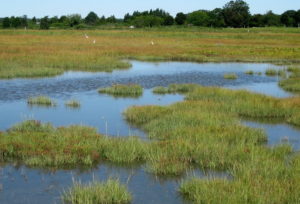In 2020, NEIWPCC began an exploratory study with rbouvier Consulting and Paul Stacey into the opportunities and obstacles to expand water quality trading in the Long Island Sound watershed. The project supports the Long Island Sound Study (LISS), a NEIWPCC program partner, in implementing their Comprehensive Conservation and Management Plan.

NEIWPCC convened an interdisciplinary team of ecologists, economists, and policy experts to analyze how an expanded trading program could support LISS goals towards clean waters and healthy watersheds.
Water quality trading is a market-based system in which activities that reduce pollution generate credits that can be sold to help other dischargers meet environmental goals. Wastewater treatment plant upgrades, agricultural strategies, and stormwater best management practices are some ways to mitigate pollution. Trading programs can serve as a tool for achieving nutrient load reductions, such as for nitrogen and phosphorus, as well as for other water quality parameters. For example, Connecticut’s Nitrogen Credit Exchange successfully reduced the amount of nitrogen from wastewater facilities by nearly 65% from 2002 to 2014.
“There’s been a lot of excitement around water quality trading as a way to make it more affordable to meet environmental goals,” said NEIWPCC Director of Water Quality Programs, Richard Friesner. “Trading had worked for wastewater treatment plants in Connecticut, and we wanted to thoroughly explore what expanded trading could – and should – look like in the Long Island Sound watershed.”
The group’s extensive research drew a clear conclusion: nutrient trading is unlikely to be an effective tool to meet water quality goals under current ecological, economic, and regulatory conditions in the Long Island Sound watershed. The analysis identified several limiting factors, including the lack of a regulatory driver to create demand for trading credits, resulting in insufficient demand to support a trading program. This is, in part, due to the success of the existing Nitrogen Credit Exchange, as well as most point sources in the watershed already discharging nitrogen well within their applicable regulatory limits.
“We knew going in that there are challenges associated with developing and implementing water pollution trading programs,” said Jane Stahl, NEIWPCC commissioner and environmental consultant. “The value of this study was to provide robust foundations in the economics and ecologic opportunities to use trading in the Long Island Sound watershed. It was a little disappointing, but not terribly surprising, to find that there is little opportunity to use trading here because, to be overly simplistic, there is insufficient demand.”
The report acknowledges that under different conditions – such as changes to the regulatory or ecological conditions in the watershed – nutrient trading could be reevaluated.
“It was important that we identified circumstances under which expanded trading might be useful to improving the health of the Sound,” continued Stahl, “and exciting to see how an alternative approach of ecosystem-based management could improve water quality throughout the watershed.”
This project has been funded wholly or in part by the United States Environmental Protection Agency under assistance agreement (LI00A00384) to NEIWPCC in partnership with the Long Island Sound Study (LISS).